Introduction and status
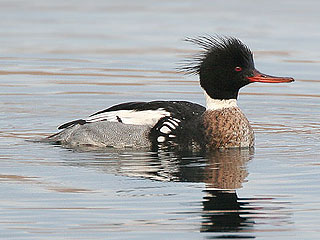 |
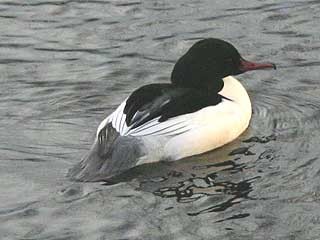 |
| Red-breasted Merganser: Note the white neck collar between the streaked breast and head. Crown shaggy and 'punk-like', flanks grey (photo: Steve Round). | Goosander: Mostly white with a dark head and white flanks. Sleek and clean-looking (photo: Chris Jones). |
Amongst the ducks, a drake Red-breasted Merganser or Goosander takes some beating; the salmon pink of the latter reflecting off still water on a crisp winter afternoon under a dwindling sun or the glossy green head of the former on a spring morning on an upland reservoir — both have little difficulty etching an impression upon us. These two members of the sawbills, so-called because of their serrated bills, are a delight to see, but it is the non-breeding birds, redheads, that sometimes cause confusion, particularly amongst those of us who have relatively little experience of either on a regular basis.
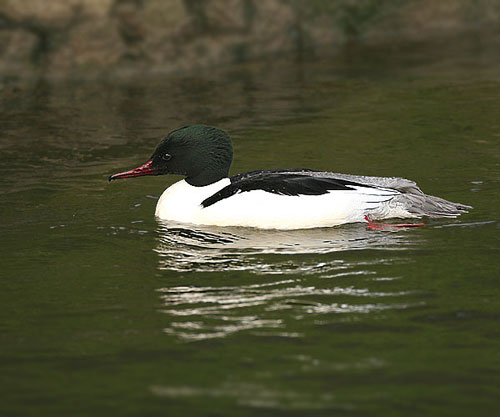 |
| Goosander: Nominate merganser can be found in Europe, from Iceland eastwards to the Pacific coast of Russia, whilst orientalis breeds in the highlands of Central Asia and americanus occurs in North America. According to BWPi, americanus is similar to nominate merganser, but in adult male the black on bases of white greater upper wing-coverts less concealed by median coverts, forming a broad bar on the speculum; orientalis differs from nominate by having a shorter, narrower, and more slender bill, and longer wing; adult females have a paler head and mantle (photo: Steve Round). |
The British breeding population of Goosanders is in the region of 2,600 pairs whilst the wintering population is around 16,000 birds. The breeding areas are confined to the upland rivers and streams of northern England, Scotland and Wales. Goosanders first bred in Britain in 1871 with the first English nesting attempt in 1941. Since 1970 the breeding range has spread across Northern England into Wales, reaching southwest England with first breeding attempts during the last 20 years in Devon and Somerset. In winter, unlike the maritime-loving Red-breasted Merganser, they can be found on open water, primarily lakes, gravel pits and reservoirs in northern and central England. Only two sites have supported a wintering population of national importance with any regularity (>161 birds), Wheldrake Ings and Eccup Reservoir in Yorkshire, though a change in management of the former probably means that such numbers are unlikely to be matched with any regularity in the immediate future. Other sites do accommodate such sizeable gatherings on a periodic basis, though none with any consistency. Ringing recoveries imply that a large proportion of our wintering birds are of British origin, which rarely winter more than 150km from their breeding areas, though some are from the Fennoscandian and northwest Russian populations, with most of the southern England wintering population considered to be birds from this population.
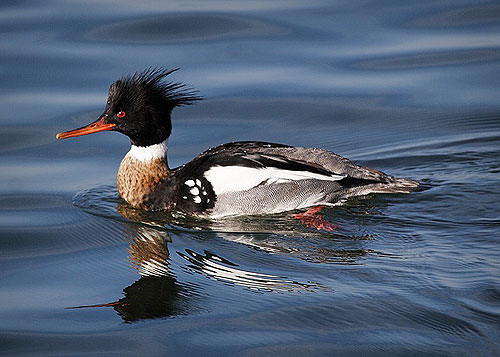 |
| Red-breasted Merganser: According to BWP Red-breasted Merganser is monotypic, though birds from Greenland have in the past been proposed as a separate subspecies, M. s. schioleri, on the basis of slightly longer wings and bill, plus the bill is said to be wider at the base though data does not support this. However, the differences are too slight and there is much overlap (photo: Sean Gray). |
The British breeding population of Red-breasted Mergansers is in the region of 2,300 pairs, the majority of which are to be found in Scotland, with others in northwest England and Wales, and in parts of Northern Ireland. There was an increase in range and numbers in Scotland from the late 19th century and the first nest to be discovered in England was in 1950. The English breeding population is put at around 150 pairs, the majority in the Lake District. The wintering population is estimated at around 10,000 birds, with wintering numbers mostly comprising birds from Britain, though ringing recoveries and occasional influxes point to a proportion originating from Fennoscandia and the Baltic. The small Icelandic population also winters here, plus possibly some birds from the population in Greenland. Coastal areas hold the majority of wintering birds, inland records are something of a scarcity, and many of the large estuaries along the south coast and northwest coast support three-figure numbers. Several sites hold nationally important numbers (>100 birds), with Poole Harbour in Dorset the most important wintering area.
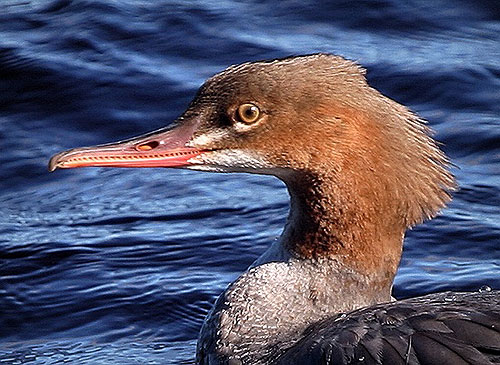 |
| Goosander: Only at close range can the serrations be easily seen (photo: Sean Gray). |
Identification of non-breeding birds
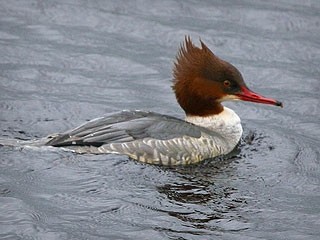 |
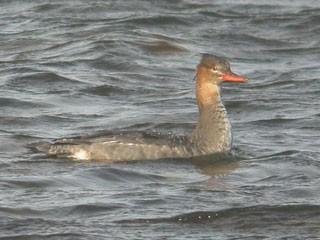 |
| Goosander: Compared with Red-breasted Merganser, has a neat division between the head and pale neck, a nice white throat and a substantial crest which makes the head look fuller. The bill has a thicker base (photo: Sean Gray). | Red-breasted Merganser: Compared with Goosander note the diffuse border between the brown head and dusky neck, plus the windswept wispy crest. The bill is narrow with a thin base and the white throat patch of Goosander is lacking. Altogether appears scruffier and smaller-headed (photo: Peter Hadfield). |
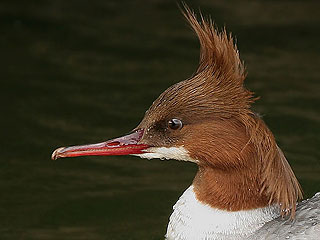 |
 |
| Goosander: Neat-looking with white chin, and full crest. Bill thicker at base than Red-breasted Merganser (photo: Steve Round) | Red-breasted Merganser: Scruffy, lacking sharp demarcation, complete with spindly crest (photo: Steve Round). |
Flight identification
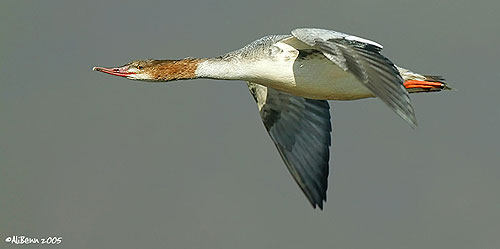 |
| Goosander: Sleek and elegant in flight, sawbills are amongst many birders' favourite ducks (photo: Alister Benn). |
Flight of both species is rapid and direct, with a slim streamlined appearance which recalls a grebe or diver. Red-breasted Merganser appears more streamlined than Goosander, but it requires experience with both species to call a distant bird instantly.
Males should present few problems: male Goosander is 'white-necked' whereas Red-breasted Merganser is dark-necked. Drake Goosander exhibits far more white on the inner wing, which in Red-breasted Merganser is less extensive and is divided by black lines.
Redheads take a bit more practice. Goosanders have a sharply demarcated head and upper breast. The leading edge of the upperwing on Goosander is paler and the white secondaries and greater coverts are uniformly white lacking the dividing black line of Red-breasted Merganser. Red-breasted Mergansers are 'scruffier', lacking that clear demarcation between the head and neck and breast, and the leading edge of the upperwing is darker. The white patch on the secondaries is separated by a black line. From underneath the flanks are clean on Goosanders, whereas on Red-breasted Mergansers they are darker and less 'neat'.
 |
 |
| Goosander: The clean white secondary patch lacks the dark bar of Red-breasted Merganser; note also paler forewing (photo: Sean Gray). | Red-breasted Merganser: Black bars across the secondary patch are noticeable at some range, as is the darker forewing (photo: Brian McGeough). |
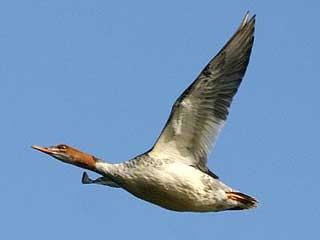 |
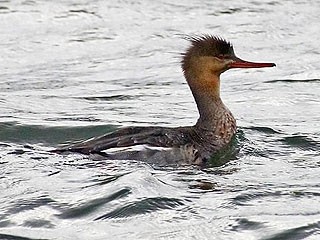 |
| Goosander (photo: Steven Fryer). The flanks are pale grey rather than dark grey as in Red-breasted Merganser. | Red-breasted Merganser: A scarce find on inland waters during the winter months. Note the upswept bill; a Goosander's bill is straighter with a drooping tip (photo: Brian McGeough). |
References
Brown and Grice. 2005. Birds in England. Poyser, London.Cramp and Simmons. 2004 Birds of the Western Palearctic interactive. Published by BirdGuides, Sheffield.
Acknowledgements
Many thanks to the photographers whose pictures are presented here. More of their work can be seen on their own websites:
Alister Benn: http://www.pbase.com/alibenn/
Sean Gray: http://www.grayimages.co.uk
Peter Hadfield: http://www.manxbirdphotography.co.uk
Brian Mcgeough: http://www.pbase.com/bmcgeough/british_birds
Steve Round: http://stevenround-birdphotography.com



